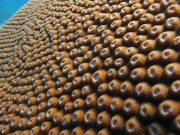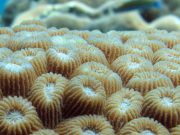Tauchen mit Wabenkorallen
Meeresleben von Lanta | Diploastreidae
An den Tauchplätzen rund um Koh Lanta finden Taucher zahlreiche Kolonien von Wabenkorallen, die zum Teil enorme Ausmaße erreichen.
Die Familie der Wabenkorallen, Diploastreidae, enthält nur eine einzige Gattung, Diploastrea, die wiederum nur eine einzige Art, Diploastrea heliopora, aufweist.
1 Arten auf dieser Seite gefunden:
Honeycomb Coral
(Diploastrea heliopora)
Honeycomb coral colonies are easy to distinguish from other coral species, and can grow to massive sizes, creating dense colonies several meters wide. Many coral species have some variation depending on depth, location, water clarity, etc., however this species has very little variation and is easy to identify.

Diploastrea heliopora @ Koh Haa
The large polyps live within corallites which are low, dome-shaped and closely packed, creating a honeycomb-like effect.
The corallite walls are thick, but not solid, rather they are formed of ridges which are the enlarged outer ends of the septa. The septa are equal and are thick at the wall and thin where joining the columellae (top/opening of the corallite).

Honeycomb coral @ Koh Bida
The coral surface appears smooth and can be cream, grey, light brown or green. This is a zooxanthellate species.
Tauchen mit Wabenkorallen rund um Koh Lanta
Tauch- und Schnorchelausflüge
Wenn Sie gerne die Gelegenheit hätten, Wabenkorallen auf einem unserer täglichen Tauchausflüge während der Hochsaison von Koh Lanta aus zu sehen, dann senden Sie uns eine E-Mail an info@diveandrelax.com.
Nehmen Sie an unseren Speedboot-Tauchausflügen in der Hochsaison zu einigen der besten Tauchplätze Thailands teil und genießen Sie kleine Gruppen, kurze Fahrzeiten und einen Fokus auf hervorragenden persönlichen Service, Sicherheit und Spaß.
Noch kein zertifizierter Taucher? Lernen Sie auf Koh Lanta das Tauchen mit dem 3-tägigen SSI Open Water Diver Kurs.
Buchen Sie online und sparen Sie 10% auf Tauchausflüge und Tauchkurse auf Koh Lanta.
Weitere Informationen
Indo-Pazifische Meereslebewesen-Führer
- Allen, G., Steene, R., Humann, P., DeLoach, N. (2003) Reef Fish Identification, Tropical Pacific. Jacksonville, FL., USA: New World Publications, Inc., ISBN 1-878348-36-1.
- Humann, P., DeLoach, N., (2010) Reef Creature Identification, Tropical Pacific. Jacksonville, FL., USA: New World Publications Inc., ISBN 978-1-878348-44-9
- Debelius, H. (2013) Indian Ocean Reef Guide. Frankfurt, Germany: IKAN - Unterwasserarchiv, ISBN 978-3-939767-52-7.
- Debelius, H. (2004) Nudibranchs and Sea Snails, Indo-Pacific Field Guide. Frankfurt, Germany: IKAN - Unterwasserarchiv, ISBN 3-925919-51-1
- Erhardt, H., Knop, D. (2015) Corals Indo-Pacific Field Guide. Frankfurt, Germany: IKAN - Unterwasserarchiv, ISBN 3-925919-69-4.
- Veron J.E.N., Stafford-Smith M.G., Turak E. and DeVantier L.M. (2016). Corals of the World
Weitere Referenzen zu Meereslebewesen und weitere Informationen
